|
|
 |
Dynamic
Programming
Data |
 |
-
Random Walk: Markov Decision Process |
 |
The inspiration for this MDP version
of the Random Walk problem is the paper Combinatorial
Design of a Stochastic Markov Decision Process, by Nedialko
B. Dimitrov and David P. Morton (in Operations Research and
Cyber-Infrastructure, M.J.\ Saltzman, J.W. Chinnek and B.\
Kristjansson (eds.), Springer, New York, 2009, 167-193). One of the problems
considered by this paper is described by the authors in this
slightly modified quotation.
| Suppose an individual moves randomly on the grid network
depicted in Figure 1.1 (repeated below). The
top-left cell (northwest corner) and the bottom-right cell
(southeast corner) are special. We seek
to guide the individual to the northwest corner, but he
vanishes from the grid if he first reaches the southeast
corner. The set of grid cells, i.e., nodes in the individual’s
spatial network, form the state space. There
are five actions available in each cell: do nothing,
close a one-way door blocking the north exit, the south
exit, the east exit, or the west exit. If we do nothing,
the individual has a 1/4 probability
of transitioning to the adjacent cell to the north, south,
east, or west in the next time period. If we
close a one-way door blocking one of the cell’s exits,
the individual has a 1/3 probability of exiting to
each of the remaining three neighboring cells. The doors
are one-way since they block movement
out of, but not into, the cell. The special cells are different:
If the individual reaches the northwest
corner, or the southeast corner he departs the grid in
the next time step, regardless of the action we
take. In the former case we receive a unit reward. The
one-step reward for the latter case, along
with that of all other cells, is 0. As a result, the goal
is to maximize the probability the individual
reaches the northwest corner prior to reaching the southeast
corner and vanishing. Equivalently,
the goal can viewed as “protecting” the southeast
corner, i.e., as minimizing the probability the
individual is allowed to transit into that cell. |
The add-in does not solve exactly the problem considered in
the paper and the paper goes far beyond the simplest of the
problems considered here.
The MDP model adds the blocking
action to the Markov Model. At each state, we allow the action
of blocking movement in one of the directions. The figure below
illustrates the problem. For this case we assume that the grid
lines wrap. When the walker reaches one of the boundaries
and attempts to move beyond it, the walker goes to the opposite
boundary. For example with the walker at (0, 1) and attempts
to move north, he will find himself at the next step at (3,
1). The wrapping is illustrated by the oval shapes that appear
to go behind the grid.
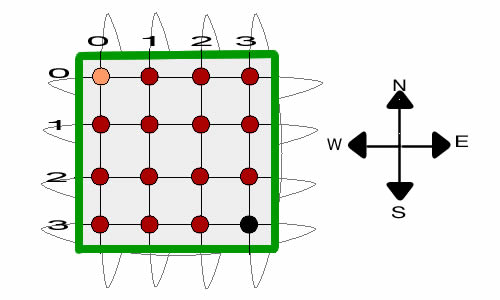
Two states are designated as final states, (0,0) and (3,3).
If the walker wanders to state (0,0) indicated by the gold
color, we win a reward of $1 and the walker leaves the grid
and goes to a final state that is external to the grid. If
the walker wanders to state (3,3) indicated by the black color,
we win no reward and the walker leaves the grid and again goes
to the final state. This is called a transient MDP because
the walker will eventually leave the grid.
The actions of the MDP involve closing the door against movement
in one of the four directions. In each state we may decide
to restrict movement or not. If restricted, we must choose
the north, south, west or east direction. We combine the decision
to restrict with the four movement directions by including
the null decision
along with the four directions. If not restricted, the walker
moves in the four directions with equal probability of 1/4.
When the walker is restricted, the probability of moving in
the restricted direction is 0, and the probability of moving
in each of the other directions is 1/3. Doors are one-way in
that they only restrict movement from the state restricted,
not from some other state moving into the state restricted.
We illustrate the doors by the short blue line close to the
node representing the state. The solution shown has the black
node entirely sealed off. All avenues of direct movement into
the black node are blocked. Note that all four doors of the
solution are not simultaneously present. A door is closed only
when the walker is in the associated state.
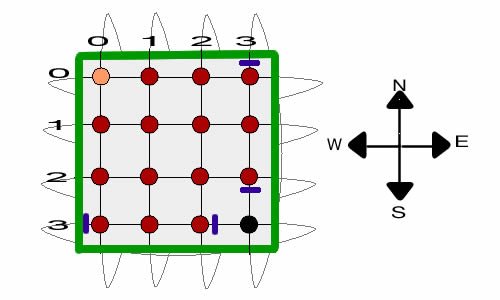
|
Data |
| |
|
The dialog for the MDP version
of Random Walk data type is shown at the left.
Only the Final option is allowed for exit states.
For this example we choose the wrap option for
boundaries, and specify 2 as the number of exit states. |
|
The data form for the Doors problem shows
the data that is fixed for the model with yellow cells.
The decision to place a door at a cell is called the
blocking decision and this form has data defining the
cost of placing the block.
We have filled in the specific data for the problem.
Note the prize for the final state (0,0) is set to 1.
In contrast to the problem presented in the paper we
indicate a block prize of -0.001. This is a small penalty
placed on using a door. Otherwise, there are many alternative
optimum solutions to the problem. The small
penalty will encourage a solution with as few doors as
possible.
There are five moving decisions, one for each direction
and one for the no-move option. To correctly reflect
the doors problem the probability of the null
move must set at 0. |
|
States |
| |
Clicking the Build Model button
creates a worksheet for the model. The MDP model has
all three elements, States, Actions and Events.
The following discusses each element and illustrates the associated
lists that define the problem for the DP Solver. |
| |
|
The state space is identified by enumerating
all integer indices from 0 to 15 in cell E14. We choose
the index 12 and the resultant state (3,0) for illustration. |
|
The state list, obtained by enumeration, has sixteen
states representing the nodes on the grid and one additional
state called the final state. This new state
is included for any problem that has exiting states designated
as a final state. |
The final states are designated in the state
subset range of the worksheet shown below. Here states
(0,0) and (3,3) are defined as final states with the word
final in V37 and V43. The prize for state (0,0)
is in V36 in the first subset. The third subset includes
all the other states that represent grid nodes.
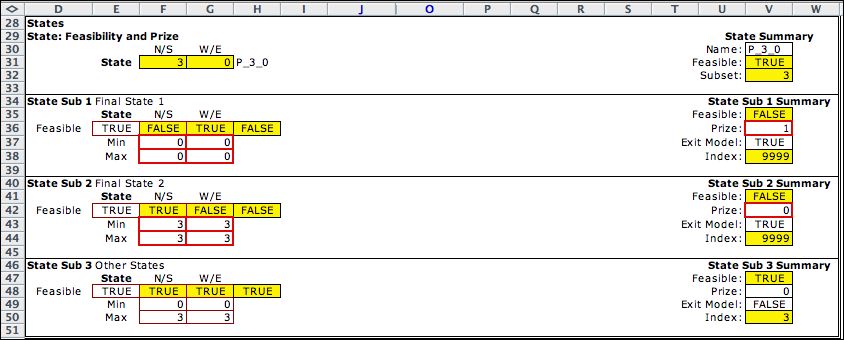
|
Actions |
| |
|
The five actions are identified with the
integers 1 through 5. For example, the integer 4 is the
block action of closing a door to the east. The penalty
for using the blocking action is in M21. The cell holds
a formula that links to the corresponding value
on the data worksheet.
The blocked probability cell in M22 is transferred
from the move probability cells on the data worksheet.
The value shown is the move to the east probability. |
|
The action list is obtained by the
enumerating the actions. |
|
Events |
| |
|
There are four move events. The interesting
thing about this problem is the computation of the event
probability in cell R22. Cell R22 holds a formula that
sums P22 and Q22. Cell Q22 holds the value of the move
probability transferred from the data worksheet.
Cell P22 holds the contribution from the block decision.
When it is the same as the move event, then the negative
of the blocked probability is entered in P22
so that the net probability is 0. |
|
When the move is different than the block decision as
is shown at the left, 1/3 of the blocked probability is
placed in P22. The net probability of the westward move
is the desired value of 1/3. The evaluation of P22, Q22,
and R22 are all accomplished through Excel formulas. The
results are valid with any valid move probabilities entered
on the data worksheet.
The formula in P22 is the only reference to the action
required on the model worksheet. |
|
The event list is obtained by the enumerating
the events. |
|
Decisions |
| |
The decision list is created by enumerating
all states and all actions. Only feasible combinations are
included. There is only one decision for state (0,0). Since
(0,0) is final state, no actions are enumerated and the action
in state (0,0) is specified as Null. The prize for
state (0,0) as well as the penalties for all blocking decisions
are in column Z. There are no decision blocks for this model,
so the list is a straight forward enumeration of all state/action
options, except for states (0,0) and (3,3).

The last few decisions are shown below to illustrate the transition
at the exit state (3,3). Row 72 shows the transition to the
final state with the associated prize. The final
state is in row 73.

|
Transitions |
| |
The transitions are defined by the transition
blocks of the model. Although the actions are included in the
transition block definition, the same transition blocks are
used as were used in the Markov Chain models. The actions play
no role in the transitions except in the determination of the
probability of transition in the event description.
These are transferred to the transition blocks and ultimately
appear as the transition probabilities in column AG.
Each decision has a set of transitions, and each member of
the set is the result of a different event. For the example,
the first row indicates the transition from state (0,0) to
the final state. Transitions 2 through 4 are for the action
of blocking north from state (0,1). The move north
event is not shown because its probability is zero. The other
three move options each have a probability of 1/3. Transition
5 illustrates a wrap transition where the state (0,1) moves
to state (3,1) with a northward move. Only the null action
has four move events, each with probability 1/4.
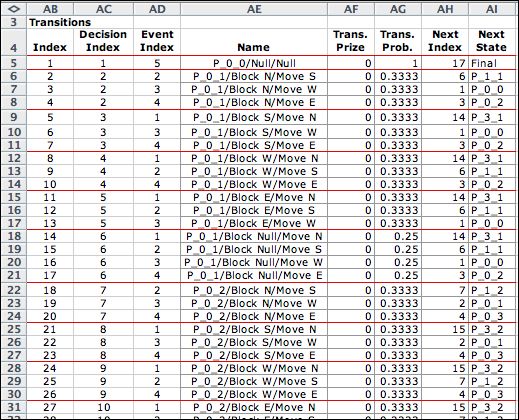
There are 227 transitions for the model. The
transition from (3,3) to the final state is 226. The final
state (state 17) is an absorbing state with 0 transition
cost and probability equal to 1.

|
Solver |
| |
The MDP model uses the DP
Solver to find solutions. The figure below shows the final
solution. Columns K and L hold the optimum policies for each
state. Column O holds the total prizes associated with starting
in each state. After state (0,0) and excepting state (3,3),
the values are all slightly less than 1 because of the small
penalties for using the blocking actions.
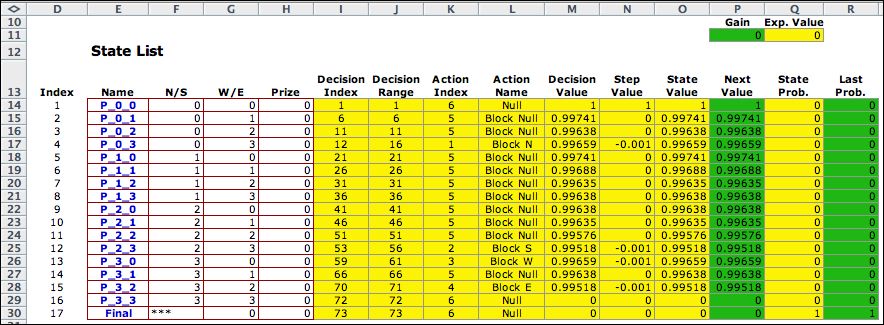
The optimum solution blocks all transitions into
state (3,3).

Fixing the solution at the optimum, we performed
20 value iterations with the walker starting at (3,0).
As the steps progress, more and more probability gets harvested
at (0,0).

|
| |
After 20 steps almost 80% of the probability is at the final
state. Eventually the final state will have almost all the probability.
Not considering the final state, the system has the characteristic
of a transient MDP.
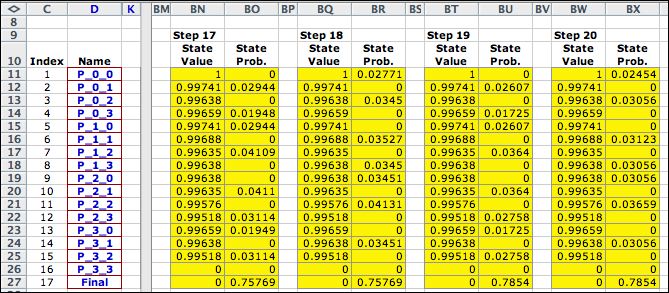
|
| |
A Markov Chain analysis of the optimum
solution shows that the expected number of steps for the system
to reach the final state from state (3,0) is13.25. |
| |
|
Discounting the Prize |
| |
The example to this point has the
goal of minimizing the probability that the walker reached
the cell (3,3). The solution accomplishes that very well by using
four doors to obtain a zero probability. With a nonzero discount
factor, the prize loses value at each step that does not reach
the state (0,0). When the discount rate is greater than 0, the
tendency would be place doors in a manner that hurries the collection
of the prize. We modify the example to introduce a discount rate
of 1% per step. All the move penalties are set to zero so as
not to confuse the effects of the discount factor with the penalty.
The solution of the revised problems is below. |
| |
|
| |
The solution has a blocking action
for every state except the two exit states. The probabilities
shown in column P are the state probabilities after 20 steps
starting from state (3,0). Over 93% of the probability has
reach the final state compared to 78% with no discounting.
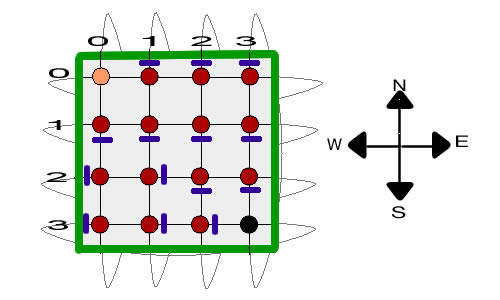
|
| |
Subsequent evaluation of the first
passage times reveals that the first passage times to the
final state are reduced for all starting states. In particular
the expected first passage time for the state (3,0) is reduced
to 8 from its value of 13.25 without discounting.

|
Summary |
| |
This page has demonstrated
one possible MDP model for the random walk. Inspired by the work
of Dimitrov and Morton, we have constructed the blocking action
for the MDP. Answers comparable to those of the paper were obtained
using our Excel add-ins. |
| |
|
|



